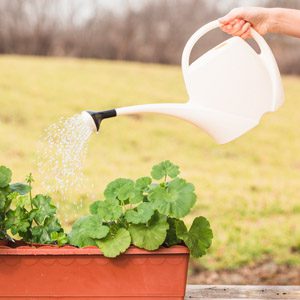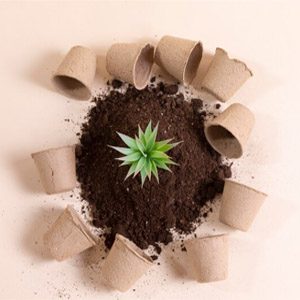
Keep your trees vibrant for a long time with these tips for root protection, effective watering, and more.
Mature trees are valuable staples in your yard because they take a long time to become established and become beautiful specimens that provide shade and year-round benefits to wildlife. Protecting your landscape by keeping it healthy is an effective way to invest in the long-term appearance of your landscape.
It’s easy to take mature trees for granted because they thrive without our help and provide great beauty and enjoyment. However, extreme weather events can cause damage. Follow these five steps to ensure your trees are healthy, resilient, and able to survive harsh winds, heavy rain, and prolonged droughts for generations.
Know your tree’s needs
 Research and write down your tree’s needs. If you’re not sure what’s growing in your yard, use the Arbor Day Foundation’s online dichotomous key to identify your trees.
Research and write down your tree’s needs. If you’re not sure what’s growing in your yard, use the Arbor Day Foundation’s online dichotomous key to identify your trees.
How much water do trees need and what type of soil do they prefer? Even if rainfall alone provides sufficient water, it is important to know the moisture conditions a tree prefers. Ideally, the tree is planted in the right place and grows well in existing soil conditions. If you are unsure whether your tree is in the right location, seek advice from an arborist.
Are trees drought tolerant? If not, monitor them carefully during periods of drought and provide supplemental water as needed.
What are trees sensitive to? Some are sensitive to high winds, salt spray, drought, overwatering, or root competition from other plants. Be aware of this sensitivity and avoid exposing your trees to stressors.
Protect tree roots
Healthy roots are essential for a healthy tree. This means healthy soil is also important. Tree roots need oxygen to absorb nutrients. This is why healthy soil has air spaces. Compacted soil is one of the biggest threats to tree roots. This is because compaction impedes water penetration and oxygen into the root zone.
The focus is on protecting roots and soil within the tree’s critical root zone (CRZ). CRZ is defined as the tree’s drip line, an imaginary circle drawn on the ground corresponding to where the tree’s branches extend. The reality is that tree roots extend far beyond the gutter lines, and the roots below ground are not symmetrical to the branches above ground. However, roots within the CRZ are the most sensitive area to disturbance. This means that you should not compact the soil or change the soil grade within the tree’s CRZ. Doing so can cause serious damage to the roots and soil structure, which can reduce the tree’s health over time.
Are you ready to redesign your garden? Find a landscape designer near you on Tree Soldiers.
Protect the bark
 The bark is like a living armor that protects the tree. If the armor is damaged, fungal or bacterial infections can easily develop and rot from the inside, harming the tree. Causes of tree bark damage
The bark is like a living armor that protects the tree. If the armor is damaged, fungal or bacterial infections can easily develop and rot from the inside, harming the tree. Causes of tree bark damage
include:
Rotate spray head: If a sprinkler head hits a tree trunk in the same place, especially at close range, it can damage the tree bark. To prevent the water stream from directly hitting the trunk, change the spray arc direction of the spray head.
Rub the branches: When branches get tangled and rub against each other, wounds form on the tree bark. See the tips below on how to properly prune branches.
Lawn equipment: Has your tree been attacked by a weed whacker? Keep lawn mowers and all lawn equipment away from tree trunks.
Vehicle: Trees near driveways and roads can sometimes be struck by tall delivery trucks or other vehicles. To prevent damage to your vehicle, you can remove lower limbs from trees in your area and use small reflectors, available at hardware stores, to make tree trunks visible at night.
Water effectively
A well-established, mature tree will grow well in existing soil and moisture conditions. However, depending on the species, soil conditions and local climate, prolonged drought can lead to extinction. That’s why it’s important to ensure the overall health of your trees so they can recover more resiliently during stressful droughts.
If you haven’t recently planted your tree, you don’t need to water it extra during the winter when it is dormant. The best time to water your tree is during summer heat or drought. Infrequent, deep watering is the preferred schedule for trees. Occasional soaking is better than frequent spraying. We recommend this with the caveat that drought is a time when we need to conserve drinking water instead of using precious resources to keep our landscapes lush. Keep your trees healthy with healthy soil to give them the best chance of surviving drought.
Proper pruning
 The dormant winter season is a good time to prune trees before they produce new growth in the spring. Look at the overall structure of the tree and choose which branches need to be removed. If you are new to pruning, it may be a good idea to hire a professional who can teach you proper techniques or do simple pruning tasks for you. Here are the basic instructions:
The dormant winter season is a good time to prune trees before they produce new growth in the spring. Look at the overall structure of the tree and choose which branches need to be removed. If you are new to pruning, it may be a good idea to hire a professional who can teach you proper techniques or do simple pruning tasks for you. Here are the basic instructions:
Crossing branches: When branches cross and rub against each other, wounds can form on the tree bark. Typically, smaller diameter branches are removed to promote the growth of stronger, sturdier branches. Trees with multiple trunks can also be pruned to straighten and thin out their shape.
Dead and broken branches: If you make a clean cut and remove the tree, it will heal on its own. Leaving dead or broken branches on a tree can cause rough breakage, introducing moisture and organisms, which can reduce the quality of the tree.
Low branches: If necessary, the tree can be “legged” to remove low branches. Removing low branches is a way to allow more light into the space beneath the tree, and is mostly for aesthetic purposes. Remove low branches that are prone to damage, such as near roads where they may be impacted by vehicles.
Maintain healthy soil around your trees
Trees in the forest grow well on their own even without human touch. Forests have an intact layer of decaying organic matter that regularly fertilizes the soil and creates a rich microbial environment that helps roots absorb nutrients. The leaf layer also retains moisture in the soil and creates a soil structure that is good for water infiltration. There are two ways to mimic this process in a home environment.
Mulch around the tree using purchased mulch or fallen leaves from your yard. You only need to store them in a 2–4-inch layer. At deeper levels, the roots become suffocated. Make sure the mulch 6is kept away from the stem and root flare.
Plant ground cover and grass to allow dead plant material to decay in the soil. You can plant shade- tolerant plants in the shade of mature trees to act as “living mulch.” Plants help maintain a healthy soil environment and can look much more attractive than bare mulch. Use plants with spreading roots to avoid root competition with trees.
 Learn more about
Learn more about
Why, when, and how to plant trees.
Browse other gardening guides.
For outdoor projects, work with a landscaping contractor.
Shop for shovels, rakes and other gardening tools

Registrera dig
November 29, 2024Can you be more specific about the content of your article? After reading it, I still have some doubts. Hope you can help me.
Рестраця
December 4, 2024Can you be more specific about the content of your article? After reading it, I still have some doubts. Hope you can help me.
open a binance account
December 20, 2024Thank you for your sharing. I am worried that I lack creative ideas. It is your article that makes me full of hope. Thank you. But, I have a question, can you help me?
Lumikha ng Binance Account
January 19, 2025Can you be more specific about the content of your article? After reading it, I still have some doubts. Hope you can help me.
binance Registrera
February 24, 2025Can you be more specific about the content of your article? After reading it, I still have some doubts. Hope you can help me.
binance
March 25, 2025Your article helped me a lot, is there any more related content? Thanks! https://accounts.binance.com/en-NG/register-person?ref=JHQQKNKN
Регистрация на www.binance.com
April 15, 2025Your article helped me a lot, is there any more related content? Thanks!
Créer un compte gratuit
May 5, 2025Your article helped me a lot, is there any more related content? Thanks!
Prihlásit se a získat 100 USDT
June 2, 2025Can you be more specific about the content of your article? After reading it, I still have some doubts. Hope you can help me.
Registrarse
August 20, 2025Can you be more specific about the content of your article? After reading it, I still have some doubts. Hope you can help me. https://www.binance.com/en-ZA/register?ref=JHQQKNKN
binance create account
August 26, 2025I don’t think the title of your article matches the content lol. Just kidding, mainly because I had some doubts after reading the article. https://www.binance.com/en/register?ref=JHQQKNKN
binance
September 6, 2025Thank you for your sharing. I am worried that I lack creative ideas. It is your article that makes me full of hope. Thank you. But, I have a question, can you help me?
Sign Up
September 28, 2025Can you be more specific about the content of your article? After reading it, I still have some doubts. Hope you can help me.
binance-
October 2, 2025Thank you for your sharing. I am worried that I lack creative ideas. It is your article that makes me full of hope. Thank you. But, I have a question, can you help me?
Premia za rejestracje na Binance
November 8, 2025Your article helped me a lot, is there any more related content? Thanks!
mejor código de referencia de Binance
November 14, 2025Can you be more specific about the content of your article? After reading it, I still have some doubts. Hope you can help me.
binance
December 5, 2025Can you be more specific about the content of your article? After reading it, I still have some doubts. Hope you can help me. https://accounts.binance.info/vi/register?ref=MFN0EVO1